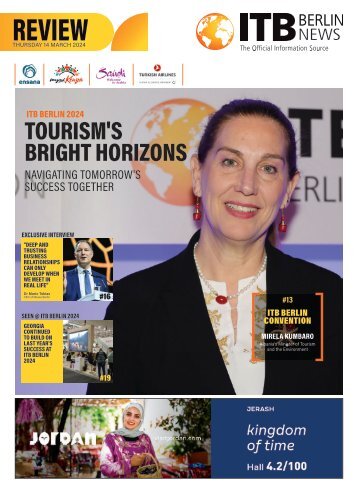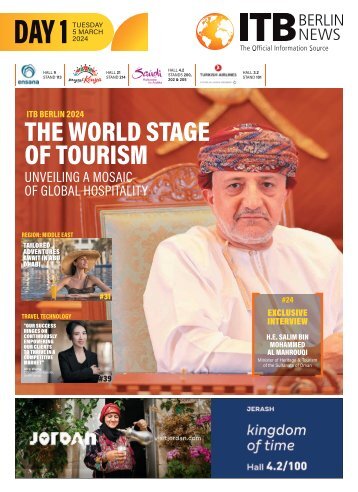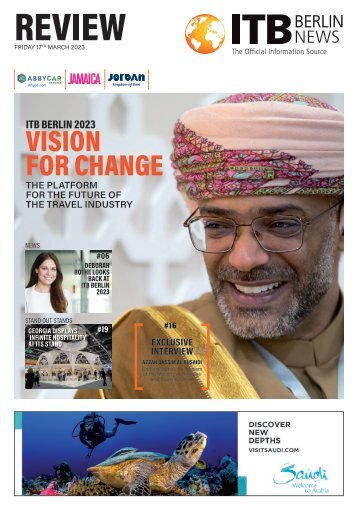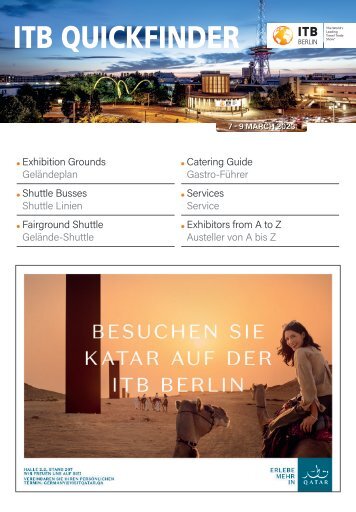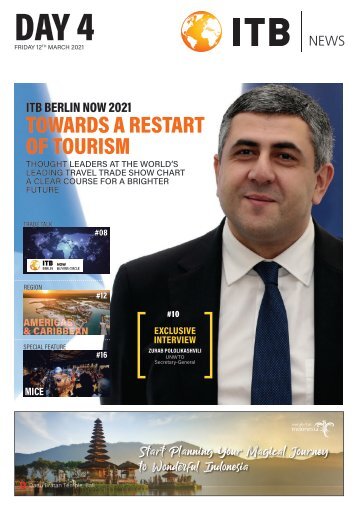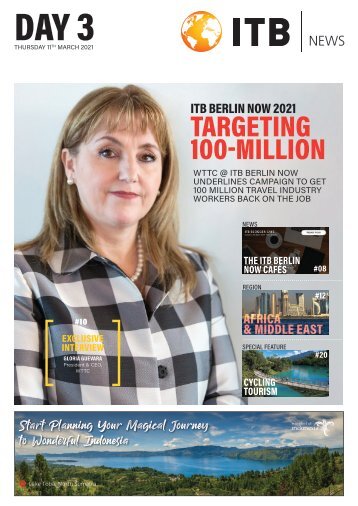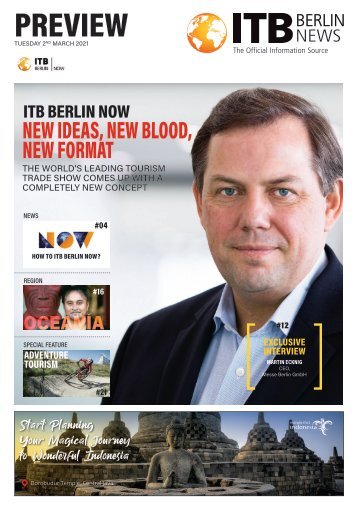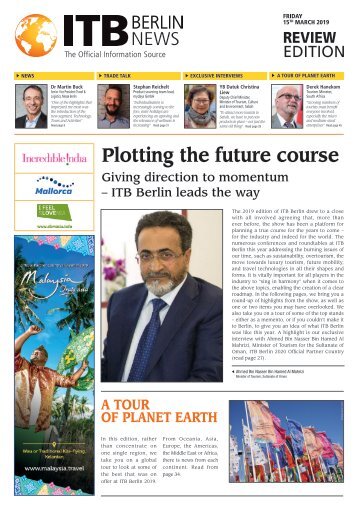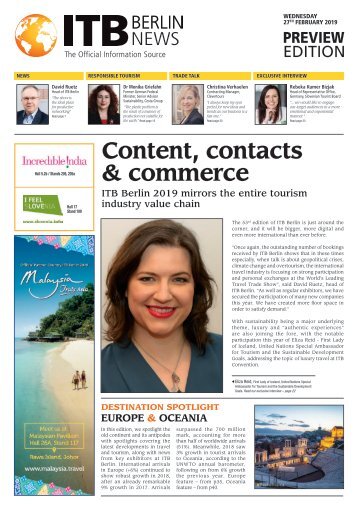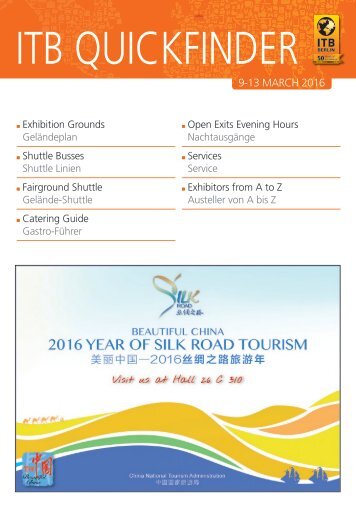
ITB Berlin News - Day 3
- Text
- Hotels
- Tourism
- Tours
- Resort
- Berlin
- Resorts
- Tourismus
- Halle
- Exhibitors
- Aussteller
28 SPECIAL FEATURE
28 SPECIAL FEATURE CULTURAL TOURISM European Cultural The soul… and the strongly beating heart of the © Thomas Wolf Hamburg Speicherstadt The European Travel Commission is back at ITB Berlin this year further consolidating efforts to promote tourism on the continent. The ETC’s newly compiled SMARTguide, released this week at ITB Berlin, covers several sectors, one of the main ones being culture. Cultural tourism accounts for around 40% of all European tourism, and while culture here dates back many decades, the concept of Cultural Routes was officially spawned by the Council of Europe in 1987. MANY ROUTES LEAD TO ROME In addressing the spirit of a modern pilgrimage, the declaration invited Europeans – particularly the young – to “travel these routes to build a society ITB BERLIN NEWS • Friday 6 th March 2015 founded on tolerance, liberty, solidarity and respect for others”. In this way, the routes leading to Rome, and from Rome to Jerusalem, the Michaelic pilgrimages and the pilgrimages dedicated to St Olav in northern Europe have progressively been added to the first route to create the most faithful and coherent image possible of the great land routes which have structured the towns and villages of Europe. The Cultural Routes programme of the Council of Europe now comprises 29 certified Routes that cover 70 countries. France (10.4%) heads the list followed by Italy (9.7%), Spain (8.4%), Portugal (5.8%), Germany (5.2%) and Great Britain (5.2%). The rest of the countries each comprise 2.6% or smaller percentages. THE WAYS OF PILGRIMAGE From its beginnings, the concept of hospitable networks (the Order of Cluny, the Knights of Malta or St John) has led to the development of a network of small businesses, initially religious, which federated agricultural and medical “clusters” to feed and care for pilgrims. Today, with the renaissance of pilgrimages, this spirit of hospitality and welcome has spawned resting points, hostels and semitourist accommodation facilities, which contribute to the local development of the villages and rural spaces traversed, creating an entire “social economy” linked to a social, supportive and ethical tourism. MARITIME AND TRADE ROUTES The Phoenicians’ routes, starting in the Mediterranean and stretching as far as the Isles of Scilly (United Kingdom), enable one to analyse the evolution of the concept of trading posts, and of the establishment of platforms for exchanges with local populations. It is equally clear that the towns of the Hansa are the first example of the THE MEANING OF MAN IN SOCIETY, IDEAS OF LIBERTY AND JUSTICE, AND TRUST IN PROGRESS creation of an economic network founded on mutual insurance and risk-sharing. The towns, particularly Bruges, also had links to the Medici Bank and the great central European markets. The Via Regia is also one of the oldest commercial exchange corridors in Europe. The Route enables one to interpret the geography and nature of these exchanges and the creation of small and medium businesses from the age of pedlars to transportation via articulated lorries on the new east-west motorways built since the last world war. www.itb-berlin-news.com
CULTURAL TOURISM SPECIAL FEATURE 29 Routes western world THE CULTURAL ROUTES OF INDUSTRIAL HERITAGE The Iron Route in the Pyrenees, primarily designed to present and interpret a network of small historic crafts enterprises which employed a cross-border seasonal workforce, and the European Iron Trail in Central Europe, showcasing the great industries of the region, are at the heart of the concept of evolution in the economic forms of work in Europe; not forgetting that they are also examples of a recent form of economic innovation: the reconversion of an industrial activity into a heritage activity. LANDSCAPES AND CIVILISATIONS The Routes of the Olive Tree and the Iter Vitis Route are particularly relevant models for studying the economy and management of landscape as well as the economic structure of small agricultural businesses before the development of the food processing industries. THE EUROPEAN ROUTE OF HISTORICAL THERMAL TOWNS This Route is particularly suited to studying the evolution of the tourism economy, from spa treatments to the development of wellbeing tourism linked to the rediscovery of one of the great historic heritages of tourism. . EUROPEAN CAPITALS OF CULTURE Another excellent way to take in some culture in Europe is to enjoy the European Capitals of Culture. This initiative by the European Commission is designed to highlight the richness and diversity of cultures in Europe, celebrate the cultural features Europeans share, increase European citizens’ sense of belonging to a common cultural area and foster the contribution of culture to the development of cities. The initiative was developed in 1985 and has, to date, been awarded to more than 50 cities across the European Union. The 2015 European Capitals of Culture are Mons (Belgium) and Pilsen (Czech Republic). EUROPEAN CAPITALS OF CULTURE HAVE ALREADY BEEN DESIGNATED UNTIL 2018 2016 – Donostia-San Sebastián (Spain) and Wrocław (Poland) 2017 – Aarhus (Denmark) and Paphos (Cyprus) 2018 – Leeuwarden (Netherlands) and Valetta (Malta) ITB BERLIN NEWS • Friday 6 th March 2015
- Page 1: FRIDAY 6 th MARCH 2015 ITB QUICKFIN
- Page 6: 6 NEWS MYSTERIES OF ANCIENT PERSIA
- Page 9 and 10: NEWS 9 Rifai Calls for Industry Sup
- Page 11 and 12: ITB BERLIN CONVENTION 11 And… ACT
- Page 13 and 14: TRADE TALK 13 MICE on the Rise The
- Page 15 and 16: EXCLUSIVE INTERVIEW 15 Strength in
- Page 17: BUSINESS TRAVEL SPECIAL FEATURE 17
- Page 20: 20 SPECIAL FEATURE GROUP TRAVEL Kin
- Page 24 and 25: 24 SPECIAL FEATURE ADVERTORIAL FAMI
- Page 26 and 27: 26 SPECIAL FEATURE ADVERTORIAL CULT
- Page 31: AFRICA / MIDDLE EAST REGION 31 MAIN
- Page 34 and 35: 34 REGION AFRICA / AFRICA MIDDLE EA
- Page 37 and 38: 37 HOSPITALITY / RESTAURANTS / BARS
- Page 41 and 42: ITB QUICKFINDER 4-8 MARCH 2015 Exhi
- Page 43 and 44: Hall 26 A / Stand 131 Hall 26 A / S
- Page 45 and 46: CATERING GUIDE & OPEN EXITS EVENING
- Page 47 and 48: EXHIBITORS FROM A TO Z AUSTELLER VO
- Page 49 and 50: A / B EXHIBITORS / AUSSTELLER HALL
- Page 51 and 52: B / C EXHIBITORS / AUSSTELLER HALL
- Page 54 and 55: EXHIBITORS FROM A TO Z AUSTELLER VO
- Page 56 and 57: EXHIBITORS FROM A TO Z AUSTELLER VO
- Page 58 and 59: EXHIBITORS FROM A TO Z AUSTELLER VO
- Page 60 and 61: EXHIBITORS FROM A TO Z AUSTELLER VO
- Page 62 and 63: EXHIBITORS FROM A TO Z AUSTELLER VO
- Page 64 and 65: EXHIBITORS FROM A TO Z AUSTELLER VO
- Page 66 and 67: EXHIBITORS FROM A TO Z AUSTELLER VO
- Page 68 and 69: EXHIBITORS FROM A TO Z AUSTELLER VO
- Page 70 and 71: EXHIBITORS FROM A TO Z AUSTELLER VO
- Page 72: EXHIBITORS FROM A TO Z AUSTELLER VO
Inappropriate
Loading...
Mail this publication
Loading...
Embed
Loading...
